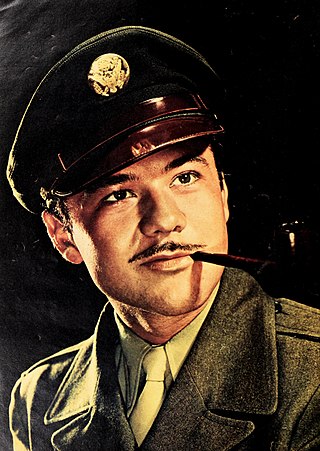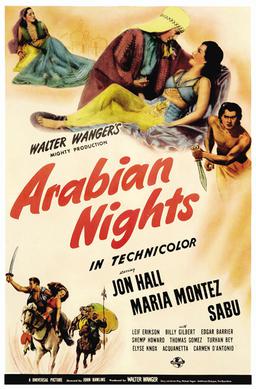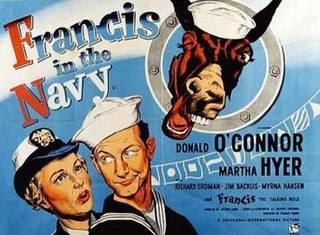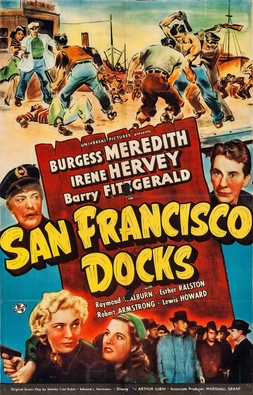
Merle Oberon was a British actress who began her film career in British films as Anne Boleyn in The Private Life of Henry VIII (1933). After her success in The Scarlet Pimpernel (1934), she travelled to the United States to make films for Samuel Goldwyn. She was nominated for the Academy Award for Best Actress for her performance in The Dark Angel (1935). Oberon hid her mixed heritage out of fear of discrimination and the impact it would have had on her career.

María África Gracia Vidal, known professionally as Maria Montez, was a Dominican actress who gained fame and popularity in the 1940s starring in a series of filmed-in-Technicolor costume adventure films. Her screen image was that of a seductress, dressed in fanciful costumes and sparkling jewels. She became so identified with these adventure epics that she became known as The Queen of Technicolor. Over her career, Montez appeared in 26 films, 21 of which were made in North America, with the last five being made in Europe.

Jon Hall was an American film actor known for playing a variety of adventurous roles, as in 1937's The Hurricane, and later when contracted to Universal Pictures, including Invisible Agent and The Invisible Man's Revenge and six films he made with Maria Montez. He was also known to 1950s fans as the creator and star of the Ramar of the Jungle television series which ran from 1952 to 1954. Hall directed and starred in two 1960s sci-fi films in his later years, The Beach Girls and the Monster (1965) and The Navy vs. the Night Monsters (1966).

Turhan Bey was an Austrian-born actor of Turkish and Czech-Jewish origins. Active in Hollywood from 1941 to 1953, he was dubbed "The Turkish Delight" by his fans. After his return to Austria, he pursued careers as a photographer and stage director. Returning to Hollywood after a 40-year hiatus, he made several guest appearances in 1990s television series including SeaQuest DSV, Murder, She Wrote and Babylon 5 as well as a number of films. After retiring, he appeared in a number of documentaries, including a German-language documentary on his life.

Follow the Boys also known as Three Cheers for the Boys is a 1944 musical film made by Universal Pictures during World War II as an all-star cast morale booster to entertain the troops abroad and the civilians at home. The film was directed by A. Edward "Eddie" Sutherland and produced by Charles K. Feldman. The movie stars George Raft and Vera Zorina and features Grace McDonald, Charles Grapewin, Regis Toomey and George Macready. At one point in the film, Orson Welles saws Marlene Dietrich in half during a magic show. W.C. Fields, in his first movie since 1941, performs a classic pool-playing presentation he first developed in vaudeville four decades earlier in 1903.

Arabian Nights is a 1942 adventure film directed by John Rawlins and starring Jon Hall, Maria Montez, Sabu and Leif Erikson. The film is derived from The Book of One Thousand and One Nights but owes more to the imagination of Universal Pictures than the original Arabian stories. Unlike other films in the genre, it features no monsters or supernatural elements.

Francis in the Navy is a 1955 American black-and-white comedy film from Universal-International, produced by Stanley Rubin and directed by Arthur Lubin. The film stars Donald O'Connor and Martha Hyer, and marked the first credited film role of Clint Eastwood. The distinctive voice of Francis is a voice-over by actor Chill Wills.

Rhubarb is a 1951 film adapted from the 1946 novel Rhubarb by humorist H. Allen Smith. Directed by Arthur Lubin, the screwball noir comedy stars the cat Orangey along with Jan Sterling and Ray Milland. Cinematography was by Lionel Lindon. The supporting cast features William Frawley and Gene Lockhart.

It Grows on Trees is a 1952 American fantasy comedy film directed by Arthur Lubin and starring Irene Dunne in her final screen role. The cast also featured Dean Jagger, Joan Evans and Richard Crenna. It was produced and distributed by Universal Pictures.

White Savage is a 1943 American Technicolor South Seas adventure film directed by Arthur Lubin and starring Maria Montez, Jon Hall and Sabu. The film was re-released by Realart in 1948 on a double-feature with the same three stars in Cobra Woman (1944) and again in 1953, under the title White Savage Woman. It was choreographed by Lester Horton.

Ali Baba and the Forty Thieves is a 1944 adventure film from Universal Pictures, directed by Arthur Lubin, and starring Maria Montez, Jon Hall, and Turhan Bey. The film is derived from The Book of One Thousand and One Nights, but its storyline departs greatly from the folk tale of the same name, wedding that story to an actual historic event. The film is one of series of "exotic" tales released by Universal during the Second World War; others include Cobra Woman, Arabian Nights, and White Savage.

Francis Covers the Big Town is a 1953 American black-and-white comedy film from Universal-International, produced by Leonard Goldstein, directed by Arthur Lubin, that stars Donald O'Connor, Yvette Duguay, and Gene Lockhart. The distinctive voice of Francis is a voice-over by actor Chill Wills.

Lady Godiva of Coventry is a 1955 American Technicolor historical drama film, directed by Arthur Lubin. It starred Maureen O'Hara in the title role. Alec Harford, the English actor who portrayed Tom the Tailor, died eight months before the film's release.

Delightfully Dangerous is a 1945 American musical film directed by Arthur Lubin showcasing teenage singer Jane Powell—in her second film on loan out to United Artists from MGM—and orchestra leader Morton Gould. The working titles of this film were Cinderella Goes to War, Reaching for the Stars and High Among the Stars. It was Frank Tashlin's first writing credit on a live action feature film.

Tangier is a 1946 American film noir mystery film directed by George Waggner and starring Maria Montez, Robert Paige and Sabu. It is set in the international city of Tangier, Morocco and was one of the last Universal Pictures films before the studio's reorganization as Universal-International in July 1946.

Bowery to Broadway is a 1944 American film starring Maria Montez, Jack Oakie, and Susanna Foster. Donald O'Connor and Peggy Ryan also had a small specialty act, and it was the only film they were in together where they didn't have a name or character.

Gypsy Wildcat is a 1944 Technicolor adventure film directed by Roy William Neil starring Maria Montez, Jon Hall and Peter Coe. It was co-written by James M. Cain.

Eagle Squadron is a 1942 American war film directed by Arthur Lubin and starring Robert Stack, Diana Barrymore, John Loder and Nigel Bruce. It was based on a story by C.S. Forester that appeared in Cosmopolitan magazine, and inspired by media reports of the fighting in the Battle of Britain, in particular, the American pilots who volunteered before the United States entered World War II, to fly for the Royal Air Force in the actual Eagle Squadrons.
Juli Lynne Charlot was an American singer, actress, and fashion designer. She was the creator of the poodle skirt.

The San Francisco Docks is a 1940 American crime drama film directed by Arthur Lubin and starring Burgess Meredith, Barry Fitzgerald, and Irene Hervey.


















